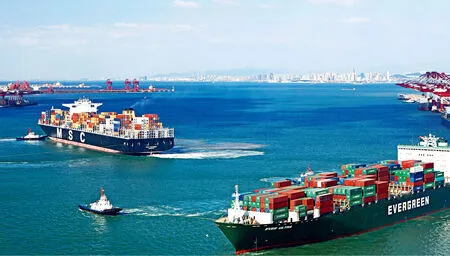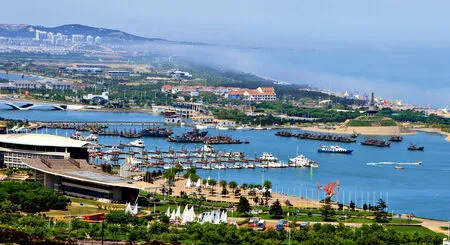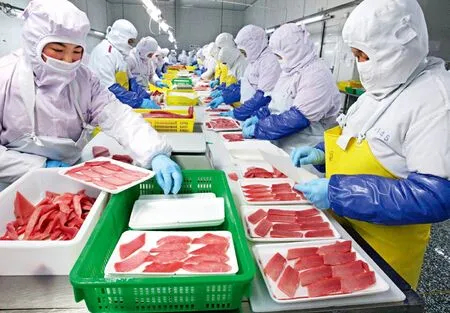SHANDONG TO EMBRACE MARINE ECONOMY POTENTIAL
2018-01-13ByWangZhe
By Wang Zhe

Container ships arrive at Qingdao port in eastern Shandong Province.
Coastal province in eastern China sees its proximity to the sea as one of its greatest economic advantages
“The ocean is the treasure house of resources, the cradle of life, the hometown of wind and rain and the thoroughfare connecting all the continents,”explained Wang Shouxin, head of the Oceanic and Fishery Department of Shandong Province. “Therefore, we need to speed up the transformation of old and new driving forces as there are lots of opportunities to develop the marine economy.Shandong, a coastal province in eastern China, has great potential in the marine economy.”
Shandong is one of China’s major marine provinces and a core base of marine scientific and technological innovation.It has an area of 159,000 square kilometers adjacent to the sea and has a coastline stretching 3,345 kilometers, accounting for onesixth of China’s total coastline.The combined value-added of Shandong’s five major industries including marine fisheries,marine transportation, marine biomedicine, marine electrical power and marine salt ranked first in the country in 2016.
Last year, the gross value of production of marine-related industries in Shandong reached 1.33 trillion yuan (US$200 billion), ranking second in China.Wang said that in the future, the marine economy in Shandong should meet requirements of environmentalism, sustainable development, comprehensive development and security.Therefore, gross value of production of marine-related industries is expected to exceed 2 trillion yuan (US$300 billion) by 2020, and the marine economy is expected to have an average annual growth rate of more than 10.8 percent.
Industry Chain of Marine Food
In recent years, Shandong has worked to develop its fisheries.Rongcheng, a county-level city at the eastern edge of Shandong,is known as the hometown of fisheries in China. In the past, the city’s plants were capable of only processing fresh fish into fish powder, before selling it on for a small sum. Now, however, fresh fish is processed and re-sold at a significant profit. Shandong Xinfa Fishery Group, which is located in Rongcheng, has built the largest tuna processing base in China, processing 60,000 tons of tuna annually. It produces a combined 30,000 tons of canned tuna, fish fillet and sashimi each year, which are exported to the United States,Japan, South Korea and several countries in Europe. Xinfa Group also manufactures tuna collagen powder and collagen peptide, which are sold at more than 1,000 yuan (US$151.9) per kilogram, hundreds of times more expensive than raw tuna.
Farmers can earn significant sums through cultivating fish instead of growing crops, which also protects the environment.Shandong focuses on its four most profitable types of seabased products — sea cucumber,kelp, seashell and whiteleg shrimp. It has established these four products as regional brands and has developed industrial chains each with output value exceeding 100 billion yuan(US$15.2 billion). Since 2005,Shandong has supported the construction of a 460,000 hectare marine ranch with a total investment of 2.08 billion yuan(US$320 million). Combined output value has reached nearly 90 billion yuan (US$13.7 billion).
In recent years, the industry of recreational fishing at sea has sprung up in Shandong. Since 2014, Shandong has set up 15 provincial-level demonstration bases of recreational fishing at sea. In 2016, recreational fishing in Shandong achieved an output value of 10 billion yuan (US$1.5 billion). By 2020, the output value of the whole industrial chain of recreational fishing in Shandong is expected to exceed 100 billion yuan (US$15.2 billion), making the industry a new engine for promoting the development of the marine economy.
Marine Equipment Manufacturing Industry Accelerated
If fi sheries are the cornerstone of marine economic development, then the marine equipment manufacturing industry is the “engine” for speeding up the marine economy.
On May 18, 2017, the successful experimental mining of marine natural gas hydrate (combustible ice) for the first time in China proved that China possesses strong capabilities in deepwater oil and gas exploration and development, leading China to an advanced level globally. Blue Whale I, the most advanced ultradeepwater dual-drilling derrick semi-submersible drilling rig,was independently designed and manufactured by Yantai CIMC Raラes Offshore Limited(CIMC Raラes), in northeastern Shandong.
Since 2017, a number of offshore platforms including self-elevating, semi-submersible and floating platforms have been put into operation in a number of marine ranches across Shandong, making an important contribution to the modernization of China’s shipbuilding industry. In the future, Shandong will also use the technological advantages of the China Shipbuilding Industry Corporation (CSIC),CIMC Raラes and Weichai Holding Group Co., Ltd., so as to build a manufacturing base of multifunctional platforms at sea and an important marine power equipment manufacturing base in northern China.
Huanghai Shipbuilding Co.,Ltd. in Weihai city in eastern Shandong constructed a specialized ship design, research and development platform,which is the only one of its kind in Shandong. The company has the production capacity to receive orders to manufacture large-scale passenger and cargo ships. Huanghai Shipbuilding has successfully delivered five large-scale luxury passenger liners since 2016, and has also built two heavy ships with load capacities of 31,200 tons each for Iran, setting a number of records in China.
Shidao Heavy Industry, also located in Weihai, has focused on the markets along the Belt and Road. In 2017, the company signed orders worth a total of 500 million yuan (US$76.4 million). Shidao Heavy Industry designs and manufactures highend pressure vessel equipment such as desalination and petrochemical engineering equipment for countries in the Middle East and Eastern Europe. So far, the company has covered markets in more than 20 countries and regions including Russia, France and Italy.
“Therefore, we need to speed up the transformation of old and new driving forces as there are lots of opportunities to develop the marine economy. Shandong, a coastal province in eastern China, has great potential in the marine economy.”
Innovation and Sharing
Still, Shandong has weak spots in the marine economy. These include a lack of coordination in land and sea projects, a scattered marine economy layout, a short marine industrial chain, an unreasonable marine industrial structure and a low rate of transformation to productivity in terms of scientific and technological achievements.Therefore, to realize and clarify the disadvantages of marine economic development,Shandong needs to vigorously develop emerging industries and actively cultivate new marine service industry methods.

A world sailing competition base and Wanpingkou scenic area in Rizhao, in southeastern Shandong Province.
In Shandong, many marine scientific research institutes are under the supervision of either the central government or provincial and municipal-level government authorities, making it difficult to maximize the utilization of scientific research resources. Recently, however,communication between central government and local government researchers has begun to improve. The resources optimization and integration of universities, enterprises and scientific research institutes have activated new drivers of growth in marine economic development. The Marine Biomedical Research Institute of Qingdao was the first corporate research institute with an industrial production orientation to be established in China. It was first founded by Ocean University of China (OUC), integrating scientific research personnel from both inside and outside of the university. The experts here not only engage in scientific research, but also specialize in the market transformation of scientific research achievements.

Workers package tuna at a seafood production company in Yantai.
Around half of China’s largescale marine scientific research ships are concentrated in Qingdao, but they are scattered across seven different scientific research institutes. The Qingdao National Laboratory for Marine Science and Technology, a national marine scientific research platform, coordinates the dispatching of 11 large-scale scientific research ships in Qingdao as a sharing resource for marine scientific research.Dong Fang Hong II, a 3,500-ton research vessel owned by OUC,completed a comprehensive observation and research of the Mariana Trench in the first half of 2017. Some 10 research institutes were involved in the expedition.
In the field of marine strategic emerging industries,Shandong will construct a seabed observation network covering the entire Shandong sea area.Shandong will also implement a“seawater utilization” project in the Jiaodong Peninsula in eastern Shandong that will be focused on seawater desalination and direct seawater utilization. By 2020,Shandong aims to achieve a daily desalination capacity of 600,000 tons, and the total amount of annual seawater utilization is expected to reach more than 10 billion tons. Shandong will also vigorously develop characteristic marine biomedicine by taking seaweed as the principal raw material, as well as seaweed fertilizer production. Shandong will research and develop marine new materials for medical purposes and construct a national industrial base of marine medical materials.In order to solve the problem of low area concentration of the marine industry, Shandong is focusing on concentrated seawater utilization and is breaking through the traditional industrial layout so as to build a number of characteristic and advantageous industry aggregative zones with strong competitiveness. As of October 2017, Qingdao (in eastern Shandong), Yantai(in northeastern Shandong)and Weihai had been listed as national demonstration cities for innovative development of the marine economy. These three cities account for onefifth of the total number of national demonstration cities in China, and the number of national demonstration cities in Shandong are also highest compared to other provinces. Each demonstration city will receive 300 million yuan (US$45.9 million) from the central government as financial support. Qingdao,Yantai and Weihai will focus on marine life and high-end marine equipment, promoting the coordinated innovation of the industrial chain in order to provide new drivers of growth for marine industry development in Shandong.
